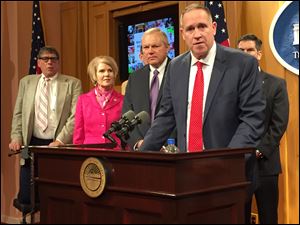
One boss in Ohio education
2/26/2018
Rep. Bill Seitz (R., Cincinnati); Rep. Dorothy Pelanda (R., Marysville); Rep. Bill Reineke (R., Tiffin); Tiffin City Schools Superintendent Gary Barber; (In rear) Rep. Craig Riedel (R., Defiance) held a press conference earlier this month in favor of a sweeping overhaul of Ohio’s educational structure. THE BLADE/JIM PROVANCE
As a matter of principal, Republicans are right to try to pare back the role of the state Board of Education.
Ohio’s education system has two bosses — the governor and the state board of education, which is part of the problem. There should only be one boss and it should be the governor.
RELATED: Reform proposal would weaken State Board of Education
The 19-member state board is hardly what could be called a representative body. Eleven members are elected and eight are appointed by the governor. At present, the district in which Toledo is located has no representative. Elected board member Kathleen McGervey, a Republican of Avon, which is near Cleveland, resigned on Jan. 6 to care for her ailing mother and has not yet been replaced.
It’s certainly true that a governor, whether Republican or Democrat, needs legislative review and oversight, but that can be provided by the state General Assembly rather than through a body that most voters know nothing about.
A bill introduced earlier this month by state Rep. Bill Reineke (R., Tiffin) would combine much of the Department of Education, the Department of Higher Education, and the governor’s Office of Workforce Transformation into a single cabinet agency, the Ohio Department of Learning and Achievement.
Mr. Reineke says the realignment would provide for smoother collaboration in developing talent for the ever-changing demands of Ohio workplaces.
Click here to view more Blade editorials | Check out the Behind The Editorial series
The state board, partially elected and partially appointed, would continue to exist, but its powers would be largely reduced to teacher licensing and discipline, charter school sponsorship, and oversight of schools for the blind and deaf. The state superintendent would continue to be hired by the board, doing whatever duties the state board would give him. But decisions affecting education policy would be made by the new cabinet head to be appointed by the governor.
Gov. John Kasich has said he would like more authority over education policy than state law and the Ohio Constitution currently give him.
Even the front-running Democrat seeking to replace Mr. Kasich, Richard Cordray, agrees, in concept, though not necessarily with the Reineke bill.
He said, “It would be a good thing for the governor of the state of Ohio to have more direct control over education policy in this state.”
It would, indeed.
Follow @BladeOpinion on Twitter.